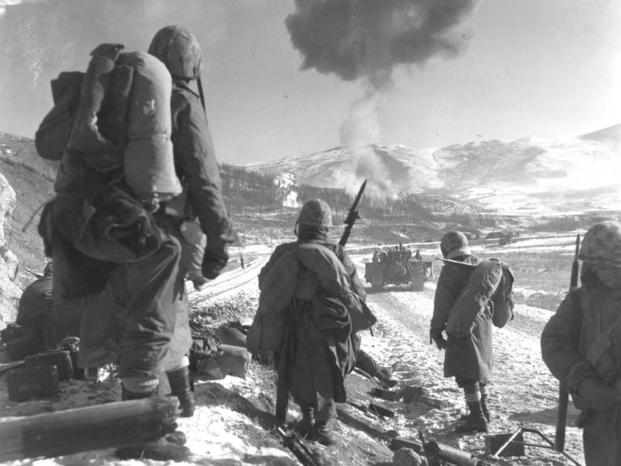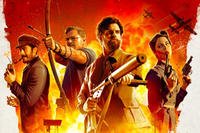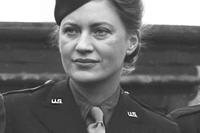BY BLAKE STILWELL - WEARETHEMIGHTY.COM
We call it “the Korean War;” the North Koreans call it the “Fatherland Liberation War.” Whatever you call it, on June 25, 1950, North Korean tanks rolled across the 38th Parallel, the border that separated the Communist-controlled and supported North from the capitalist and Western-backed South. It was the first test of Western adherence to the Cold War doctrine of containment, a strategy to stem the forced spread of Communism worldwide.

It was a brutal war that pitted the Soviet Union, People’s Republic of China, and North Korea against the United Nations, led by the United States and South Korea. The war started with a wildly swinging pendulum of momentum that almost drove Western forces into the Sea of Japan. They were saved only by a heroic UN stand at the Pusan Perimeter and one of the most daring amphibious landings in history at Inchon. The Western counterattack drove the Communists all the way to the Yalu River, the North Korean border with China. The subsequent Chinese intervention pushed the then-heavily outnumbered Americans back to the original border and a subsequent two-year stalemate until an armistice ended the fighting in 1953.

It was in Korea that some of the most legendary American military heroes said their most famous lines, made their most famous stands, and overcame seemingly insurmountable odds. The Korean War came just after the long, good fight of World War II, at a time when the world was weary of war. Just a few years later, the cultural fabric United States would be forever altered with coming of the war in Vietnam. Being sandwiched between and subsequently overshadowed by these other two, the Korean War has come to be called the Forgotten War, both by historians and the men who fought there. In an effort to relegate that nickname to the dustbin of history, here are some facts about the Korean War you may not have already known.
1. A U.S. Army sergeant in Moscow was the catalyst
Stalin prevented a war on the Korean Peninsula since the end of World War II, for fear of an all-out war with the West. When the KGB recruited an Army NCO from the code room at the U.S. Embassy, they discovered the U.S. had moved the bulk of its forces in the region to Japan. Stalin now believed the U.S. would not move to defend Korea and gave North Korean dictator Kim Il-Sung the green light to invade the South. Stalin was wrong. The Army sergeant’s identity was never discovered.
2. The South was far from Democratic

Rhee with Gen. Douglas MacArthur
The first President of South Korea, Syngman Rhee, jailed or assassinated his political opponents. He also had an active secret police force to root out North Korean agents, but they detained, tortured, and killed many innocent civilians. Days after the start of the Korean War, he ordered the Bodo League Massacre, killing more than 100,000 suspected communist sympathizers and their families. Rhee was ousted when thousands of protesters overran the Blue House in 1960.
3. The U.S. knew about the North’s military buildup
The nascent CIA noticed the North Koreans moving their army toward their Southern border but thought it was more of a defensive measure. They reported to Secretary of State Dean Acheson that an invasion was unlikely. They didn’t know the Soviets already broke American military and diplomatic codes and knew the U.S. couldn’t mount an effective response to an invasion.
4. It was technically a “police action”

President Truman never asked Congress for a declaration of war, and Congress didn’t offer one. That was back when we cared about these kinds of things. Instead, Truman placed the fighting under the aegis of the United Nations, since Korea itself was a construct of UN agreements. For the first time since WWII, U.S. troops fought in combat at Osan, thirty miles South of Seoul.
5. The U.S. dropped more ordnance on Korea than in the entire Pacific during WWII
The Korean War absolutely devastated North Korea, and this memory is a major reason why so much animosity still exists to this day. The United States dropped 635,000 tons of bombs on the North, compared to 503,000 pounds dropped on the entire Pacific Theater in WWII, killing an estimated 12-15 percent of the population. Curtis LeMay estimated an even higher proportion – he claimed 2o percent.
6. It featured the first all-jet dogfight
On November 8, 1950, 1st Lt. Russell Brown engaged a MiG-15 in his F-80 Shooting Star. The MiG was clearly a superior fighter and this discovery led to the development of the F-86 Sabre. It wasn’t superior enough to allow the MiG to win the dogfight, however. Lt. Brown downed the Communist jet. The skies over Northwest Korea featured many dogfights in the war years and soon became known as “MiG Alley.”
7. Frostbite was one of the most prevalent injuries

Thousands suffered from frostbite, while many suffered from trench foot or a combination of both. Temperatures during some of the coldest fighting were as low as -54 degrees fahrenheit. The MASH unit (Mobile Army Surgical Hospital) was just one of many battlefield medical innovations designed to stay close to the front and save the lives of more combat injured troops.
8. Seoul changed hands four times
The South Korean capital sits just 35 miles from the North-South border. It was first captured by the North Koreans on June 28, 1950, just three days after the North invaded. It was retaken by UN forces that September. The Chinese seized the city in January 1951 but lost it two months after that.
9. The first year was the deadliest

Roughly a quarter of all Americans killed during the Korean War died between August and December 1950, during the battles of the Pusan Perimeter, the Chosin Reservoir, and Kunu-ri Pass. 178,426 UN troops died in Korea, compared to more than 700,000 Communists. The first American, Pvt. Kenneth Shadrick died near Osan.
10. Army Special Forces created an army of their own
The 8240th Army Unit, Army Rangers and other soldiers with experience in partisan warfare from World War II raised and advised local partisan armies in Korea on how to fight behind enemy lines and sabotage the Communists. The 8240th would advise more than 38,000 partisan fighters.
11. It was more than just Americans and Koreans fighting Communists

Ethiopian troops fighting in Korea
Being a UN police action, other countries joined the coalition of forces fighting to keep the South safe for capitalism, if not democracy. Significant forces came from Great Britain and the Commonwealth countries, especially Australia and Canada. Turkish forces faced their biggest military challenge since World War I at the Battle of Kunu-ri Pass. Other countries who gave significant troops included Ethiopia, Colombia, Thailand and the Philippines.
12. Generals weren’t far from the fighting
These days, you don’t hear much about general officers in the thick of the action unless they’re visiting a combat unit or are on some sort of tour or inspection. That wasn’t true during the Korean War. General Douglas MacArthur went to Korea himself during the Battle of the Pusan Perimeter to assess the situation there and determine how to proceed (the Inchon Landing is what he came up with).

From left to right: Puller, MacArthur, and OP Smith
Army General William F. Dean was among the last to retreat from Taejon as the North advanced. He wanted to make sure all his men and material made it out as orderly and safely as possible. While trying to help a wounded troop, Dean was knocked unconscious and captured by the Communists.
As the war raged on in and around the peninsula, a slew of Generals would find themselves in combat. Oliver P. Smith directed the breakout of the Marines surrounded at the Chosin Reservoir and led them back to the port of Hungnam. Chesty Puller was still racking up awards and decorations in Korea. He was promoted to Brigadier General after landing at Inchon and fighting at the Chosin.
13. The Korean War never ended

Armistice talks took more than two years to complete. The real hang-up was over the repatriation of POWs. Eventually, the North conceded and an armistice was signed. The signatories didn’t end the war, however, just the fighting. The war continues to this day.
14. Korean War veterans are becoming just as rare as WWII vets

The conflict itself fizzled out quietly. The men who fought in Korea didn’t come home to parades or parties and kissing in Times Square. The job of fighting the Communists fell to the generation who bore the burden of combat without hesitation or complaint, even after the world forgot the heroism they displayed or the people they kept safe. At the rate of an estimated 500 per day, they are slowly and silently passing into history, just as their war did.
 Blake Stilwell is a traveler, writer, and adventurer with degrees in design, television & film, and international relations. He is a veteran US Air Force Combat Photojournalist who has worked for ABC News, NBC, and HBO. Blake is based in Hollywood, but often found elsewhere.
Blake Stilwell is a traveler, writer, and adventurer with degrees in design, television & film, and international relations. He is a veteran US Air Force Combat Photojournalist who has worked for ABC News, NBC, and HBO. Blake is based in Hollywood, but often found elsewhere.
MORE POSTS FROM WE ARE THE MIGHTY:
This US Army sergeant started the Korean War by selling out to the Soviets
Here's what would happen in a war between North and South Korea
Don’t panic (yet) about the post-Brexit British military
We Are The Mighty (WATM) celebrates service with stories that inspire. WATM is made in Hollywood by veterans. It's military life presented like never before. Check it out at We Are the Mighty.




